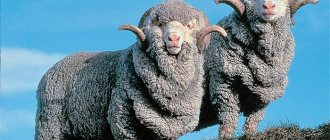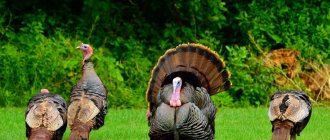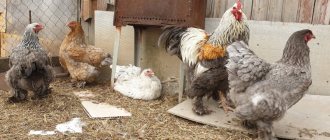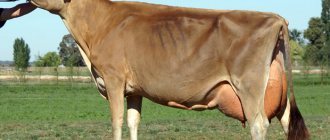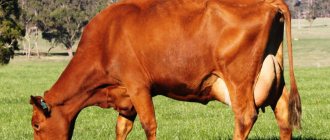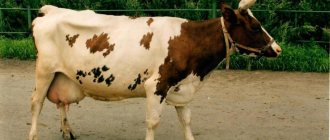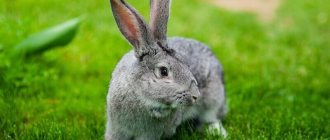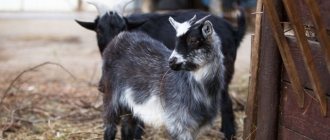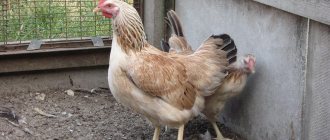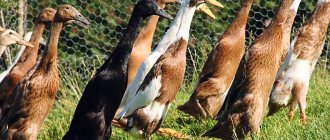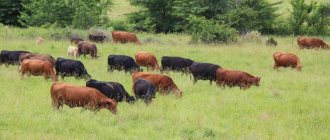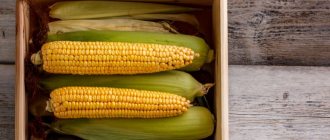The red-and-white cow breed was registered in the Soviet Union in 1998. Before this, for many years in a row, local scientists developed a new, improved type of cattle by crossing Holstein bulls and Simmental cows. They wanted to create universal representatives of cattle: with high milk productivity, physically strong, hardy, unpretentious, and also with a high life expectancy.
In the late 70s of the 20th century, experts carefully selected local animals, which were then used for breeding. After the formation of the "broodstock", the cows were inseminated with the sperm of Holstein bulls. As a result of this, calves of the first generation were born.
— Advertising —
From 1990 to 1998 there was a further stage at which the best representatives were selected. These animals marked the beginning of dynasties that already belonged to a new breed of cattle - the red-and-white.
The animals quickly became popular, spreading to farms in most regions of the country.
Today in Russia there are 10 breeding factories, 1 breeding farm for breeding red-motley cows and 7 reproducers. Reproducers are specialized farms where exclusively purebred livestock, predominantly male, are bred. Bulls are used to transform a regular herd into a breeding herd.
Origin and distribution of the species
The country of origin for the Holstein breed is Holland.
It became widespread thanks to American farmers. However, they considered especially valuable not brown cows with white spots, but black-spotted cows. The red-and-white breed was bred through the efforts of the best breeders from the Central Black Earth, Volga, West Siberian and East Siberian regions. The selection of individuals for breeding began in 1977. The stage continued until 1989.
The period of formation of the broodstock ended with the artificial insemination of cows with sperm from brown Holstein bulls. The genotype and phenotype of first generation calves have been carefully studied. It was decided to continue selective selection of young animals.
In the course of the work, the best representatives were selected, who became the basis for a new dynasty. Crosses of the second and third generations showed highly valuable qualities of their grandparents.
The bred cow has become widespread throughout Russia. Its special value lies in its easy adaptability to any climatic conditions.
Individuals are found in the pastures of the Volga-Vyatka, Central Black Earth, Volga, West Siberian and East Siberian regions. Animals not only grow well, but also show good milk production under different growing conditions.
The breed received official confirmation of its existence in 1998. The population is recognized as open for further improvement. Currently, scientists are making attempts to create intrazonal rock samples. It is planned to divide into the following types:
- Central Chernozem;
- Povolzhsky;
- Siberian
The best indicators are distinguished by Voronezh, Belgorod, Altai and Krasnoyarsk farms.
Origin story
As a separate breed, red-and-white cows are one of the youngest varieties of cattle. Breeders began working on developing such a breed in the 70s of the 20th century. The basis was taken from two breeds of cows: Simmental and Holstein red-and-white.
The crossing operation continued for approximately 20 years. As a result, by 1998, a new breed was officially developed, which was immediately recorded in the stud book. But the improvement of this type of cattle is still ongoing.
Characteristics of cattle
The breed's appearance is typical of the Holstein. From the Simmental ancestors, the cows inherited large sizes and a voluminous udder. The individual is of the dairy type, and therefore has characteristic advantages.
Advantages of the breed
- high milk productivity;
- good ability to acclimatize;
- resistance to various infections;
- precocity of calves;
- The resulting products are of high quality.
Disadvantages of the breed
- need for quality feed;
- possible manifestations of udder defects (disproportionate location, too large or small nipples);
- low stress resistance. It is believed that cows of this species are sensitive to changes in external factors.
The disadvantages are easily offset by following the recommendations for breeding livestock.
The average life age of a cow is 20-30 years. The total number of periods is three. An animal between one year and 18 months is in the maturation stage. Then, within 15 years, the cow gives offspring and milk. This period is called maturity. The third stage lasts up to 10 years and is called old age. The offspring at this stage are not born or are born with deformities, and lactation disappears.
The most productive are heifers aged 2 to 4 years. In large farms it is not customary to keep cows older than 15 years. The immunity of animals kept in factories for maximum profit is weaker than that of pets.
Appearance
The red-motley cow has the following appearance characteristics: dark brown color with white spots located throughout the body, large individual. Other features:
- strong bones;
- wide chest;
- height 144 cm;
- weight more than 700 kg;
- small horns;
- elastic skin;
- strong short legs.
The body condition of an individual is an important parameter when choosing for livestock. The factor is determined by feeling the muscle tissue and visually identifying the area of the fat layer. Muscle tissue is hard, and fat tissue is soft.
Comparative average data for different dairy breeds of red cows
| Suits | Milk, kg per year | Fat indicator,% | Belkov, % | Adult weight, kg |
| Danish Red | 8634 | 4,20 | 3,50 | 550 |
| Red-and-white | 5500 | 3,80 | 3,40 | 650 |
| Red Holstein | 8423 | 4,30 | 3,40 | 350 |
| Swedish Red | 8730 | 4,30 | 3,50 | 550 |
The weight indicator depends on the age of the animal. The older it is, the more muscle mass, and the individual will be heavier. An important factor is the food used in the diet.
What is the milk yield of a cow?
Cattle milk productivity is associated with the following indicators:
- weight and age;
- individual breed qualities;
- taking into account time standards for milking;
- with seasonality.
Interesting
The average milk yield per day of dairy animals is 15-20 liters. In 305 days, up to 2,000 kg can be obtained from heifers. Cows with four to five calvings already produce up to 8,000 kg of milk over the same period. Individual individuals of the dynasty are milked up to 10,000 kg of product.
The milking of a cow continues for 3-4 months after birth. In the future, productivity will decline. In order for the individual to continue to produce milk in sufficient quantities, the farmer needs to provide a new mating in a timely manner. Cattle milking can continue for a year after calving. Productivity drops in the second year after, especially if the individual did not have time to become pregnant with the next calf.
Milking should be done strictly on time, for example, at intervals of 8 hours. A deviation from the norm of 10-12 minutes is allowed, otherwise milk production will decrease. In addition to strict adherence to the schedule, it is worth noting:
- mandatory daily cleaning of the barn from manure and food debris;
- drinking enough. It is desirable to install automatic drinkers;
- eliminating drafts in the room. Ensuring optimal temperatures;
- regular walking in special areas or pastures.
Compliance with the preparatory stages will ensure better milk production and will also increase the period of stable lactation of the individual.
Protein content and milk fat percentage
The potential of milk production is directly related to the methods of feeding and housing livestock. High performance cannot be achieved without a balanced energy diet. Average percentages in milk of the red-and-white breed:
- proteins – 3.2;
- fat – 3.8;
- lactose – 4.8.
Human digestibility of protein is up to 95%. By increasing the level of useful components in this product, the agricultural producer is guaranteed to increase the profitability of the farm.
The varietal characteristics of the types of dairy products produced depend on the protein content. This means: the fattier the product, the better the quality. Compared to black-and-white breeds, red ones produce fattier milk. It has been established that genotype indicators influence the fat content of the product by 50%, while external factors influence only 40%.
If farmers want to increase the fat content of milk, they add more flax and sunflower cake, hay from legumes and cereal crops and seeded grass to the feed.
Wild herbs from meadows growing on acidic soils will have a negative impact on the level of fat content. Feed should not be overly crushed. At the same time, if they are coarse and fibrous, this will also reduce the fat content of the resulting dairy product.
Productivity
For this indicator, the region in which the cows are bred plays a huge role.
- Milk fat content varies between 3.2−3.9 percent, and the highest threshold was observed in cows in Ukraine, Estonia and Siberia.
- Breeding farms are distinguished by high milk yields, which sometimes reach 6500 kg during the lactation period. Competing on various indicators and fighting for leadership, state farms constantly record their achievements in terms of milk yield. Today, the record is considered to be in the range of 10,000−12,000 kg. Today only one breed of animal can produce such an amount of milk - the black-and-white cow.
- The characteristics of meat productivity differ significantly. Only about 50% is the meat yield from the carcass. Of course, a bull will have a much higher rate.
There are several types of breed that differ in milk yield and external characteristics, depending on the breeding sites. These indicators are greatly influenced by housing conditions, the original type of livestock, as well as the level of breeding throughout the region.
Features of keeping red-motley breed
Both on factory farms and in households, animals are often kept on a leash. Livestock walking is provided in the summer from early morning until dark. In winter, it is possible to organize short-term stays outside. A separate area is required for this, organized with the help of reliable fencing.
There are usually several sections on the site. They are needed to protect the bulls from the cows. It is customary to separate breeders from young animals. Stronger individuals will not allow them to the feeders.
In the barn itself, with the help of organized ventilation, a microclimate is created with a temperature of 5 degrees Celsius in winter and up to 16 degrees Celsius in summer. The room should not smell strongly of ammonia, hydrogen sulfide, or carbon dioxide. Odors arise due to elevated indoor temperatures and lead to diseases in the herd. Red-motleys have high resistance to low temperatures.
Among the specific requirements for keeping breeding cows, it is worth noting the mandatory treatment of premises from flies. Preventive measures are also needed to prevent the appearance of helminths. Parasites affect the condition of the animal; because of them, both the milk and meat productivity of the herd decreases.
How to choose food
The main food supply for this dynasty:
- hay;
- haylage;
- silage;
- roots;
A balanced daily diet for an adult is as follows:
- hay – 5 kg;
- silo – 11 k;
- 3 kg of concentrates (cake);
- 6 kg chopped vegetables.
It is advisable to include about 60 g of table salt per day in your diet.
If you feed the cows according to the recipe, this will allow you to get consistently high milk yields. The bulls will gain weight up to one kilogram per day.
During the day, animals are given about 50 liters of water. In hot weather, the norm can be increased to 70 liters.
Increasing the portion of feed can lead to obesity. For breeding bulls, this threatens the loss of reproductive function. In young animals, the disease “rumen tympany” occurs. This is acute bloating of the abdomen, accompanied by profuse release of gas. Obese cows move little and suffer from joint diseases. Childbirth in obese cows is not without complications.
Before walking on pastures, it is recommended to reduce the amount of succulent feed. In summer, the cow receives this type of nutrition along with green grass. For cows, vegetables are attractive in taste: they can be left in small quantities as a treat. This will help improve milk productivity. A larger number of root vegetables in the summer is undesirable, because their remains indoors quickly rot, attracting flies, wasps and other insects.
How to feed animals
The average amount of food for one adult red-motley breed: hay at least 8 kg, root vegetables (mostly beets) approximately 15 kg. This will help maintain the productivity of the animals. A mandatory component of feed for this type of cattle is concentrated feed and compound feed. Their volume in the diet should be reduced when the dry period begins.
Important! It is recommended to supplement the animals' diet with pea and oat straw. This will help provide the cow's body with large quantities of protein and energy for growth.
How much concentrate and feed to give cows depends on how often the cow is milked during the day. When carrying out such procedures more than 2 times a day, such food should be given immediately before milking. But the animal must be given hay and succulent feed twice a day: in the morning and in the evening.
Animal walks and feeding process in summer
In the summer, cows should be switched to pasture and succulent green feed. In addition, the menu must definitely include hay from various grasses (8 kg for one animal) and beets (about 15 kg). The diet should also include succulent food in the form of melons and vegetables. The annual feed requirement for one individual is approximately 72 centners.
Animals should be fed before being sent out to pasture. Otherwise, greedy and uncontrolled consumption of herbs can cause gastrointestinal disorders and other serious diseases. For this purpose, it is necessary to use feed present in the winter diet.
Features of feeding in winter
In the cold season, the menu of this type of cattle should include roughage, succulent and combined feed. Preparing animal feed for the winter should be done in advance. The amount of feed is calculated in accordance with the following standards: 1.5-2 kilograms per 100 kg of live weight. Food should be balanced. The diet of a dairy cow during the cold period should consist of:
- wheatgrass hay – about 9 kg;
- legume and grass hay – approximately 2-3 kg;
- silage – approximately 2-3 kg;
- haylage - about 8-9 kg;
- feed - about 3 kg.
Important! The diet of cows should be changed gradually by introducing small portions of feed, increasing them over time.
Drink
Animals should be given clean water to drink. The daily norm is at least 50 liters. When feeding babies, this volume should be increased. During this period, individual individuals can drink up to 100 liters per day. It is worth noting that the water should be heated to 27-28 degrees, since drinking cold liquid can cause colds. For this purpose, you can get a special drinking bowl that will heat the water.
Red-and-white cows are one of the productive and unpretentious breeds, although when keeping such animals, you still need to follow certain sanitary and veterinary standards and feed them properly. This will help maintain productivity at the proper level and keep the animals healthy for a long time.
Peculiarities of calving in the red-motley cow
Heifers show the first signs of heat when they are one year old. Early mating of young animals is not welcomed by veterinarians, therefore, both in domestic and industrial farms, contact of heifers with bulls is reduced to a minimum at least until the age of two.
Calving of grown-up two-year-olds will take place without complications. The birth process can take from 15 minutes to one hour.
Complications in the form of miscarriages or fetal death are rare in red-and-white cats. If a large farm has a veterinarian, a specialist will eliminate the possibility of birth diseases. When kept at home, it is also important that a doctor examine the cow at least once a year. This will prevent many problems, as well as extend the reproductive period of the animal. On average, one cow can give birth to up to 10-12 calves in her entire life.
After calving, pay attention to the condition of the udder. To protect against mastitis and frostbite, especially in winter, the floor of the barn should be lined with a layer of straw.
If a farmer plans to further keep a red-motley cow and a calf together, he must immediately be placed under the cow so that she licks him.
If the young animals are planned to be fed separately, the fetus must be removed so that the mother does not see or hear it.
Performance
Cows of this variety produce at least 5,000 liters of milk throughout the year. On average, the annual milk production of red-and-white cows reaches 6.5-7 thousand liters. However, it should be noted that throughout the entire existence of this species of animals, many individuals produced about 10 thousand liters of milk per year, and sometimes more. The milk of such cows is characterized by increased fat content. The average fat content of dairy products reaches 3.9%.
This breed of cow stands out among other varieties of cattle also due to its increased meat productivity. Steers produce high-quality beef, its yield reaches 55.9%. And the meat yield of cows can reach 54%, but for this the animal needs to be fattened accordingly.
Calves
Caring for a newborn kept separately consists of timely feeding and cleaning of the barn. Every two hours, the young are fed colostrum from their mother.
Weak individuals are bottle-fed, but usually babies feed on their own from the first hours of life. Therefore, a regular bucket is suitable for feeding, which you just need to hold with your hands. His active animal can turn him over.
For the first ten days, the calf only needs milk, about two liters at each feeding. In the following days, feed hay and gradually increase the amount of liquid. Two weeks after birth, a healthy animal will not refuse ground grain. Complementary feeding should begin with small portions of treats.
With proper feeding, young animals gain up to 200 kg of weight by about six months of age.
Nuances when purchasing a cow
The physical condition of an individual will tell a lot about its health. The red-and-white cow from the photo above will help you understand this important parameter. A healthy cow in reality on the market will be characterized by energy, a clear and deep look.
A dairy cow should not be too old. Antlers will help determine age. Just count the number of rings and add two. Swirls on the shoots appear with each calving. If a female cow first became a mother at the age of two, then the counting method will make it possible to determine her age with sufficient accuracy.
Important
A good cow is one that has calved 2-3 times by the time of purchase. She has already shown her ability to bear children and will continue to please with high milk yields. The benefits from such an acquisition will be obtained as quickly as possible.
If the animal was well cared for in its previous habitat, its physique should be fit and its udder should be clean and barrel-shaped. Too droopy indicates poor-quality milk yield.
If you have enough patience and skill, you can purchase a young heifer. From an early age, the animal will remember its owner and will not show an obstinate character. It is easy to tame by giving him treats and affection. Cows are sensitive, so they take a long time to get used to a new place.
Economic importance
The Holstein cow is a dairy animal. With double milking, you can get 60-65 liters of milk or more every day. The maximum milk production rate recorded in this breed is 3.21-3.51 kg/min.
The productivity of the breed is 6600-7100 liters during the lactation period. Milk fat content is up to 3.8%. In addition, the meat of cows is of high quality. The main focus is on bulls as they are used to improve other breeds. A sire is judged by the daughters obtained from it. The improver of the Simmental breed is bulls of red-and-white color. In addition, they are used for other breeds that have a red color.
Diseases of the red-and-white breed
The Holstein Red-and-White breed of cows is a dairy cow; the main problems faced by breeders are udder diseases. For example, swelling often occurs after calving. At the same time, the organ looks plump, and the amount of milk decreases. The condition can be improved with proper maintenance and feeding. The cow is given less grain and succulent feed.
Bruising is another common occurrence for cows. In this case, a bruise is formed, which affects the state of lactation. The general appearance of the animal is usually painful. Cattle are entitled to complete rest. You can apply therapeutic compresses to the udder.
If hygienic standards for maintenance are not met, furunculosis will appear. Multiple ulcers form on the organ. These wounds need to be treated with disinfectant ointments, lubricated with iodine and ichthyol oil.
Even with improper milking, cracks often form on the nipples. They cause serious inflammation. To avoid this, it is important to wash the udder skin with warm water and lubricate it with Vaseline. In addition, the cracks cause pain to the cows. She will behave restlessly and will not stand still during milking.
Productive characteristics of Holstein cows
The productivity of the Friesian breed varies greatly depending on the country. In the States, Holstein cows were selected for milk yield, without paying attention to the fat and protein content of milk. For this reason, American Holsteins have a very high milk yield with a relatively low fat and protein content.
Important! Holstein cows are very demanding when it comes to feed.
If there is a lack of nutrients in the diet, the fat content of milk may fall below 1%, even with sufficient feed.
Although the average milk yield in the States is 10.5 thousand kg of milk per year, this is offset by the low fat content and low percentage of protein in milk. In addition, such milk yield is achieved through the use of hormones that stimulate milk production. Typical Russian-European indicators are in the range of 7.5 – 8 thousand liters of milk per year. At Russian breeding farms, black and piebald Holsteins produce 7.3 thousand liters of milk with a fat content of 3.8%, red piebalds - 4.1 thousand liters with a fat content of 3.96%.
Now the concept of dual-purpose cattle is already losing its position, but so far Holstein cows have good productivity not only in milk, but also in meat. The slaughter yield from the carcass is 50 – 55%.
A calf at birth weighs 38–50 kg. With good maintenance and feeding, by the age of 15 months, calves gain 350 - 380 kg. Then the bulls are sold for meat, as weight gain decreases and keeping calves becomes unprofitable.
Which nurseries sell cows?
The breeding base of the breed in Russia is represented by 17 breeding farms and 57 breeding reproducers.
The largest breeders are located in:
Penza;
- AGROPOSTAVKA LLC.
- JSC “TROITSKOYE”.
Breeding heifers are sold at prices starting from 215 rubles/kg.
Moscow;
- INTERSIGNAL LLC.
The farm is engaged in wholesale sales, selling special ones in quantities of 25 pieces at a price of 100 thousand rubles per barrel.
- LLC "ERMOLOVSKOE"
Farmers sell breeding bulls of this breed with an average weight of up to 500 kg. Animals are offered exclusively for breeding at a price of 200 rubles/kg. The slaughter of purchased breeding animals is prohibited.
Naberezhnye Chelny;
- IP Shaimardanov R.N.
The farm is engaged in breeding various types of breeding animals and offers various sales options.
Kursk;
- LLC "ZASCHITNOE"
Farmers from Kursk sell only this breed. You can choose both bulls and heifers for breeding the herd.
Average price of cows
| Region of Russia | Cost in rubles |
| Moscow and Moscow region | 95 thousand-135 thousand |
| Saint Petersburg | 75 thousand – 98 thousand |
| Tatarstan | 48-65 thousand |
| Dagestan | 40-60 thousand |
| Omsk | 55-75 thousand |
| Altai | 45-62 thousand |
| Krasnodar | 65-74 thousand |
| Pskov | 42-60 thousand |
| Udmurtia | 48-75 thousand |
| Stavropol | 55-80 thousand |
| Krasnoyarsk | 40-75 thousand |
| Voronezh | 38-60 thousand |
| Orenburg | 41-58 thousand |
As can be seen from the table presented, the cheapest individuals are in the central part of the country, and in the center the cost is higher. This factor greatly depends on purebred. The red-motley breed of cows is more expensive on farms, but cheaper from private owners. But the latter often cannot provide documents even about the vaccinations they received.
If a cow is chosen to provide milk for a family, you can purchase a young heifer cheaply from a private owner. However, to start a serious business, it is worth considering options from breeding farms that are provided with all certificates.
Breed standard
Russian breeders were involved in breeding the breed.
| horns | not long |
| head | large, proportional to the body |
| breast | deep, wide |
| frame | elongated, proportional |
| muscles | underdeveloped |
| backbone | strong |
| limbs | long, wide apart, strong, with short pasterns |
| wool | short, shiny |
| suit | red |
| height at withers | heifers - 132–138 cm; bulls - 140–145 cm |
Did you know? Milk with a record fat content of 14.06% was produced by a Jersey cow. From a representative of the same breed, over 14 lactations, it was possible to obtain 211,235 kg of milk with a fat content of 5.47%.
Feedback on content
On the forum they write different things about breeding cows. For example, Irina Gerasimova speaks of them as cute, from which you can take bulls for fattening.
User “Vadim_83” warns about the caution with which you need to select breeding individuals from abroad. At the same time, foreign sellers do not recognize the defects of their goods, but refer to low-quality Russian feed, which they feed after purchase.
The user “Irina” also confirms that it is better to purchase individuals for breeding from local breeders, it is more reliable.
“Rella” believes that problems with foreign representatives could arise due to long transportation. In general, they are not much different from domestic cows. With adequate care and proper maintenance, they will also produce a lot of milk.
